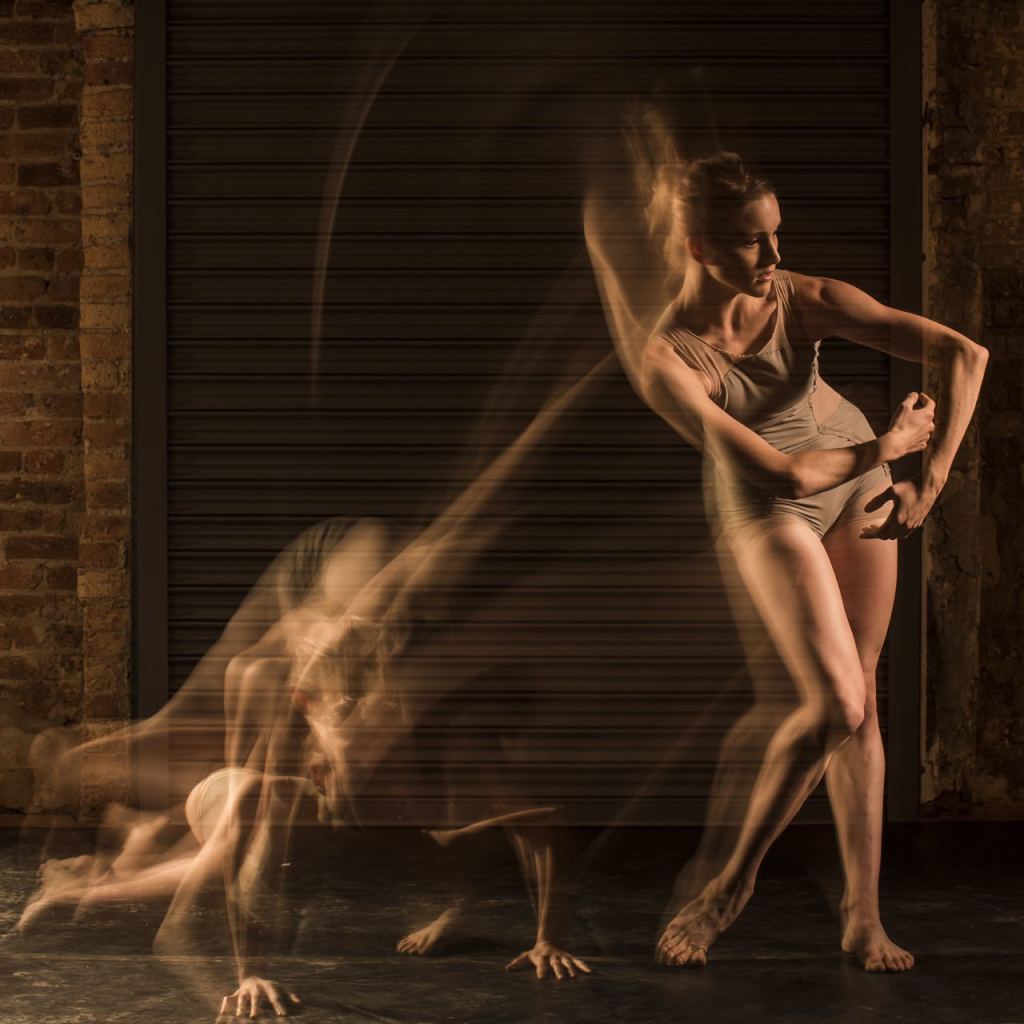
by Andrea Thompson
I am now in my second year with Hubbard Street 2 (HS2), and it has been quite the season so far. We’ve already created two new works through the International Commissioning Project (IC Project) which we just premiered on tour at Broward College, and we’re working on our third right now, which will debut at the Harris Theater as part of Eat + Drink to the Beat on December 16. Not to mention HS2 also collaborated with Hubbard Street’s main company and The Second City on the world premiere of The Art of Falling back in October. Here’s how all of that action has gone down in the studio:
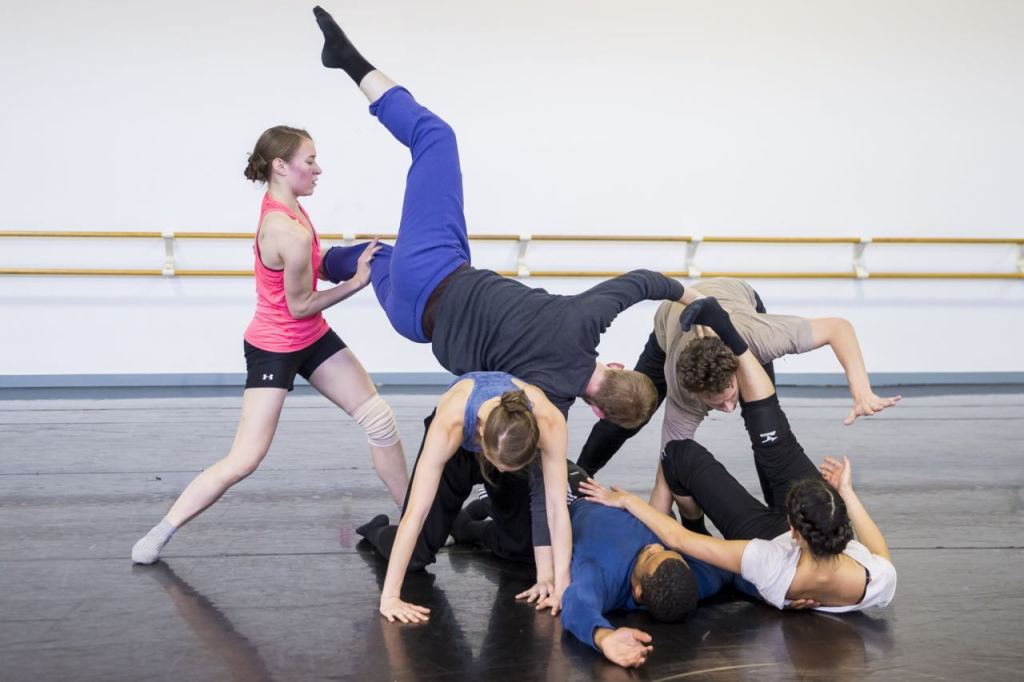
Long Story Short
For our first IC Project creation, we worked in residence at Indiana University Bloomington. The piece Long Story Short is the product of our unique experience with Ihsan Rustem (“eee-sahn ROO-stem”), a London-born choreographer now based in Switzerland. The first morning of his residency consisted of Ihsan creating some phrases with HS2 dancers, followed by an afternoon spent with students from the IU Contemporary Dance department. In order to audition the students, HS2 helped Ihsan teach the material we had just learned ourselves; in fact, the entire creation included this extra element of creating something new and immediately turning around to pass the information on to others. Two casts of IU students learned Long Story Short, and getting them up to speed in rehearsal necessitated that we HS2 dancers be on top of our games. We had to constantly be ready to relay brand-new movements and ideas with confidence, so we were super focused, trying to soak up every bit of information Ihsan had to offer. There was never a moment when the whole studio wasn’t abuzz with activity.
Ihsan arrived with a plan for the shape of the piece: He knew it would have driving music that used text from Allen Ginsberg’s poem, Howl; dramatic lighting; and striking, high fashion–inspired costumes, but he had no pre-set movement material. Ihsan generated choreography spontaneously, primarily by drawing on his own imagination, but with input from the HS2 dancers, too. For instance, the phrases Ihsan created that first morning with us became the basis of male-female duets the HS2 dancers made. Ihsan then tinkered with the duets one at a time, smoothing them out and giving each his distinctive aesthetic stamp: full-bodied, larger-than-life movement characterized by complex, risky partnering peppered with moments of delicacy. After creating our duets, we split them apart to create solos, which he fine-tuned in a similar way.
Ihsan was constantly pushing us to expand, get lower, get larger, travel more — it was hard work, but we were reaping visible rewards. As the HS2 dancers rehearsed the piece and worked with the IU students, we watched each other grow in leaps and bounds. Teaching the IU dancers movement from our group sections forced us to unify our ideas and make them clearer. Verbalizing out loud how we handled weight with our partners led to a greater understanding of the mechanics for ourselves. And the IU dancers held us accountable for everything we told them: They were constantly watching and learning from us, so we had to make sure we were setting the right example, in terms of both professionalism and the details of the work itself.
We were making a piece that was very definitely meant for the stage — for it to have the proper effect, we had to be big and confident enough to reach the back rows of the theater. Magnifying yourself is exhausting, and Ihsan demanded a lot from us but, in return, he offered an infinite supply of energy and encouragement. He would tell us honestly if he thought we had more to give, but in a way that made us want to try again until we were the best we could possibly be. Thanks to the way Ihsan pushed us and the intimate knowledge of the piece that we gained by working with the IU students, the work felt right at home onstage when it premiered at Broward College in November, in Bailey Concert Hall. The elements of costume, lighting and music that Ihsan envisioned came together in the piece’s heightened atmosphere. Long Story Short is a world that somehow contains both clarity and chaos, in the midst of incalculable possibilities.
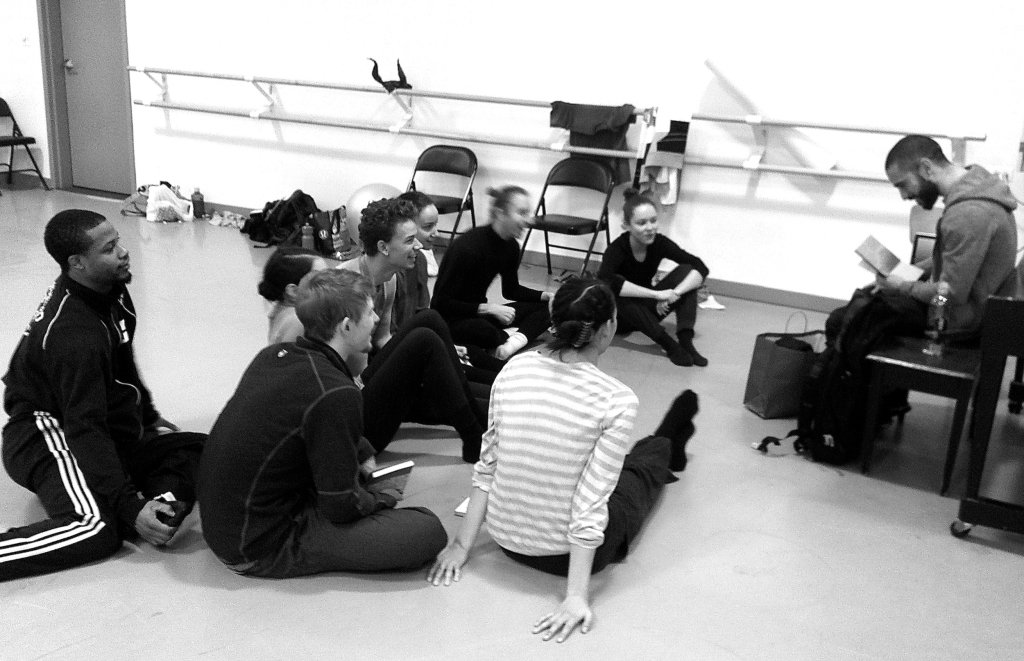
Commissioning Project choreographer Bryan Arias. Photo by Andrea Thompson.
Changed in its Affection
Following Ihsan’s process were our performances of The Art of Falling with The Second City. Once those were over, the HS2 gang was feeling funny, and I mean that literally: We couldn’t stop trying to make each other laugh. I think choreographer Bryan Arias, from Puerto Rico and based in New York, picked up on the lightness of our group spirit as soon as he entered the studio. The playfulness, ease, and relaxation we felt are reflected in the piece he created with us, Changed in its Affection. Our entire first day with Bryan was devoted to improvising, which was like advanced-dance playtime: We HS2 dancers were free to do as we pleased, and some very strange and wonderful moments came out of that freedom. While we improvised, Bryan suggested ways of moving that eventually became integral in his finished work, such as extreme articulation, initiating movement from a singular point on the body, being crystal-clear and specific, and “group listening”: trying to be aware of everyone in the room at all times. We made a lot of what he called “soups” — open improv scores with a known list of tasks that anyone could yell out for the group to do. Nearly every day, we used these soups as a way to refamiliarize ourselves with his process, coming from the structure of our daily ballet class. Bryan recorded video of a few of these soups and used their spatial ideas for the piece.
The first set steps that we created with Bryan had a degree of freedom to them. He split us into pairs and we created duets based on our individual interpretations of a list of commands, such as “grab,” “twist” or “step.” Once we had gone through the whole list, he had us go back through what we’d made and add in things like sliding steps, moments of “drama,” and traveling through space. Some partners put a comedic spin on their dramatic moment, much to the delight of everyone watching, and in some form those moments still live in the final version of the piece.
Similarly to Ihsan, Bryan also asked us to turn our duets into solos, which he worked and reworked for each dancer. The duet material we came up with was used as a basis for the duets we now have, but in most cases they took on an entirely different shape after Bryan sculpted and added substance to them. He, too, came to HS2 with not a single step prepared, yet managed to build detailed phrases effortlessly. In addition to being a prolific creator, Bryan has a sharp editorial eye. We actually made two sections that were cut entirely from the final piece, and our solos were subject to changes until the very last day he was with HS2. But above all Bryan emphasized honesty and humanity in dancing, and his changes, once incorporated, made the piece feel more authentic to each of us. He challenged us not to try to be “fierce” or showy in his work, but to relax and allow the extremity of the articulations and initiations to speak for themselves.
The dancing in Changed in its Affection is extreme, but more in its exaggeration of details than an athleticism that hits you like a freight train. Bryan worked with us extensively on the subtlest of shadings. These tiny tweaks and changes are what give the piece its distinctive feel: partly humorous, partly serious, and 100% cool. It was an absolutely delightful process, challenging to be sure, but the environment of play and exploration he maintained throughout allowed us to take risks without fear. The memory of that playful, magical place helped us to continue pushing the work forward as we enjoyed performing it for the first time at Bailey Concert Hall. Changed in its Affection closed the show, as it will at the Harris Theater on December 16. Ending a program feels like the perfect place for it, because it gives us a fun time to look forward to, even when we’re nearing exhaustion. (Being tired and sweaty also lends itself to the deadpan opening of the piece.) We become more animated toward the end when we dance literally to the lyrics of Bob Dylan’s classic “The Times They Are a-Changin.’” That’s a favorite moment of everyone in HS2, because Bryan has built into his work a place for all of us to be our silly, ridiculous and human selves. He is someone who choreographs with the intent to connect dancer and audience, and I think he achieves that in this piece by way of the heart.
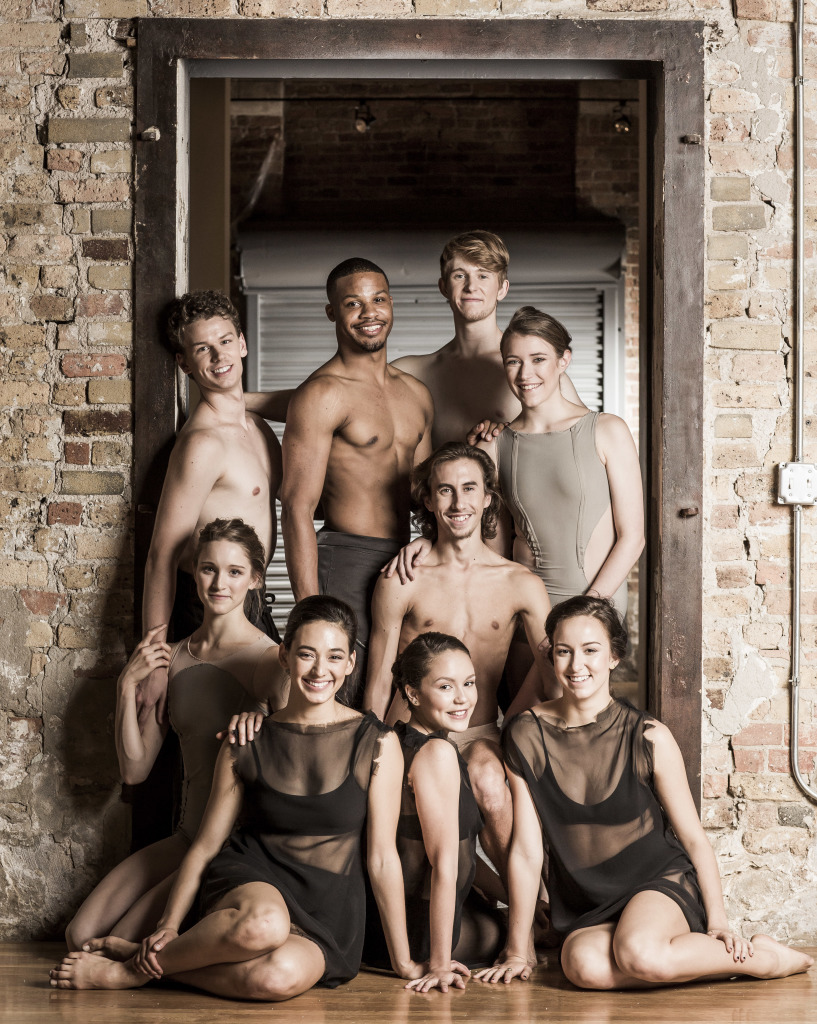
Myers, Adrienne Lipson and Andrea Thompson. Photo by Todd Rosenberg.
Parting Shadows
Victor Alexander is from Cuba but lives here in Chicago, where he’s a member of the company Hedwig Dances and director of the Ruth Page School of Dance. He began his process with us by teaching two phrases he came up with in advance, and creating a duet that we all learned with a partner. In our second or third rehearsal, he read a quote from Plato’s famous “Allegory of the Cave,” which he used as inspiration for the piece. He then had us create solos with the quote in mind, strung some of those together, and added them to a phrase he had prepared. We all learned this “mega-phrase” and, as a result, everyone learned bits of everyone else’s choreography. Victor also asked us to turn our full-bodied solos into stationary gesture phrases, which he then watched, edited, and turned into a men’s sequence and a women’s sequence. We made additional partnered material in duets and trios whereby Victor demonstrated the first two actions, then invited us to continue those sections as we wished; we also took these apart to create solo movement phrases, which we all learned. We even made a series of duets around a chair, using one of Victor’s original duets as a starting point. He wasted no time, and this all added up to a very productive start to the process: Within the first three days, we had created almost fifteen minutes’ worth of raw choreographic material!
Since Victor is based in Chicago, we’ve worked off and on with him throughout the entire fall season, instead of concentrating our rehearsals into two weeks of working together all day, every day. After our first three rehearsals for Parting Shadows, we let the piece simmer for about a month and a half. It has been a challenge to retain so much material in our brains without practicing every day, but Victor has been incredibly patient and understanding. We’ve made use of video quite extensively throughout our whole process, which has been really interesting, as we have access to the genesis of all of the material, as well as documentation of how it has evolved. Being able to see where movements came from, the first day they were created, is invaluable when you have to step away from a particular way of moving for six weeks. Additionally, having this sort of schedule has also allowed time for reflection and given us dancers the opportunity to talk on our own about where we feel the piece is going and how we can get it there most effectively.
Most recently, Victor has made two casts of four dancers each. He’s arranged and overlapped material, swapped some male and female roles, created longer solos, and reinserted material from the archives of our process — editing and focusing the piece as he goes along. As it currently stands, we have the structure of a completed work for four dancers, with moments of unison, duets and solos. With all of us onstage the whole time, it’s an aerobic work, but a good challenge. Victor has given us a lot of freedom to make our own decisions in terms of details and timing the choreography to the music, which is really liberating. I can’t wait to see how he shapes the final form of Parting Shadows!
I also can’t wait to be back onstage at the Harris Theater, for a performance completely dedicated to Hubbard Street 2 and 15 years of the International Commissioning Project. We’re beyond excited to share these three contrasting, brand-new pieces with a Chicago audience, especially since our biggest shows usually happen on tour. Take a break from your holiday madness and treat everyone to Eat + Drink to the Beat — tickets are only five dollars and we’ll be dancing our hearts out.
Hubbard Street 2 celebrates 15 years of the International Commissioning Project at 5:30pm on December 16, for “Eat + Drink to the Beat” at the Harris Theater for Music and Dance (205 E. Randolph St.). Food trucks will be parked outside the Level 1 theater lobby, on Lower Randolph, with signature cocktails available inside. Tickets are $5 each and available now, online at harristheaterchicago.org or by phone at 312-334-7777. Box Office hours are Monday–Friday, noon–6pm.
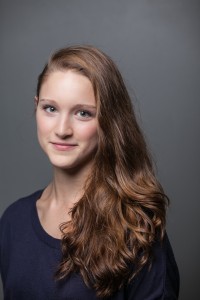 Contributor Andrea Thompson (Maplewood, NJ) trained at the New Jersey School of Ballet, American Ballet Theatre’s Jacqueline Kennedy Onassis School and the Ailey School in New York City. Thompson has also studied at the Juilliard School, Northwest Professional Dance Project, Springboard Danse Montréal, Nederlands Dans Theater and Batsheva Dance Company, which brought opportunities to perform choreography by Gregory Dolbashian, William Forsythe, Natalia Horecna, Jessica Lang, Marina Mascarell, Idan Sharabi, Robyn Mineko Williams, Paul Lightfoot and Sol León. At the San Francisco Conservatory of Dance, under the direction of Summer Lee Rhatigan, she trained with and performed works by Christian Burns, Alex Ketley, Thomas McManus, Robert Moses, Ohad Naharin, Alessio Silvestrin and Bobbi Jene Smith. Thompson joined Hubbard Street 2 in August 2013, following work in San Francisco and New York with Zhukov Dance Theatre, Chang Yong Sung, LoudHoundMovement, Backwoods Dance Project and the Foundry.
Contributor Andrea Thompson (Maplewood, NJ) trained at the New Jersey School of Ballet, American Ballet Theatre’s Jacqueline Kennedy Onassis School and the Ailey School in New York City. Thompson has also studied at the Juilliard School, Northwest Professional Dance Project, Springboard Danse Montréal, Nederlands Dans Theater and Batsheva Dance Company, which brought opportunities to perform choreography by Gregory Dolbashian, William Forsythe, Natalia Horecna, Jessica Lang, Marina Mascarell, Idan Sharabi, Robyn Mineko Williams, Paul Lightfoot and Sol León. At the San Francisco Conservatory of Dance, under the direction of Summer Lee Rhatigan, she trained with and performed works by Christian Burns, Alex Ketley, Thomas McManus, Robert Moses, Ohad Naharin, Alessio Silvestrin and Bobbi Jene Smith. Thompson joined Hubbard Street 2 in August 2013, following work in San Francisco and New York with Zhukov Dance Theatre, Chang Yong Sung, LoudHoundMovement, Backwoods Dance Project and the Foundry.






[…] the theater and others would step out for a bit. Around show number three we started making time beforehand to do an “improv soup,” à la Bryan Arias, to warm up and connect with each other before the house opened. These got pretty ridiculous, with […]